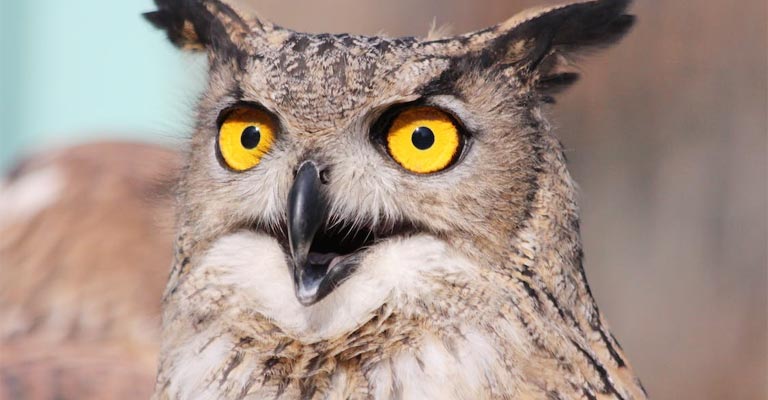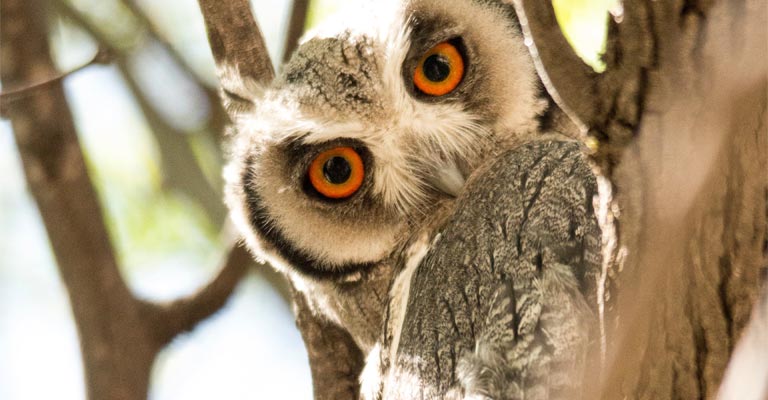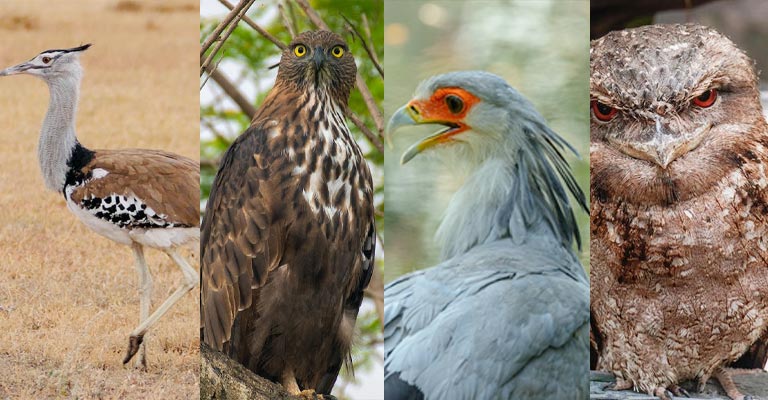Owls, those enigmatic and nocturnal raptors, have long captured the imagination of humans with their striking features, most notably their disproportionately large eyes.
These captivating creatures are renowned for their ability to see clearly in the darkness of the night, a feat made possible by their remarkable ocular adaptations. But why do owls have such large eyes, and what benefits do these oversized orbs confer upon them?
Exploring this question not only unveils the intricacies of owl biology but also provides insights into the wonders of nature’s evolution.
In this investigation, we will delve into the myriad reasons behind the remarkable ocular proportions of owls. From enhanced low-light vision to an intimidating stare, the advantages of these large eyes are multifaceted.
We will dissect the evolution of this feature and its role in the survival and hunting strategies of owls, shedding light on the fascinating world of these nocturnal avian predators.

Why Do Owls Have Such Large Eyes?
Owls have large eyes for several reasons, each of which contributes to their unique hunting and survival strategies. Here are the reasons why owls have such large eyes:
Enhanced Low-Light Vision
Owls are primarily nocturnal hunters, meaning they hunt during the night. Their large eyes allow them to capture and process minimal light effectively.
The increased surface area of their eyes’ retinas, which are sensitive to dim light, enhances their vision in low-light conditions, helping them spot prey in the dark.
Improved Depth Perception
Large eyes provide owls with excellent depth perception, crucial for accurately gauging the distance between themselves and their prey. This depth perception helps them judge the precise moment to strike, increasing their hunting efficiency.
Wider Field of View
Owls have a wide field of view due to their large eyes being positioned at the front of their face. This positioning grants them binocular vision, enabling them to focus on a single target and estimate distances accurately.
A broad field of view also helps them monitor their surroundings for potential threats or competitors.
Sharper Focus
The large size of owls’ eyes allows for a greater number of light receptors (rods and cones) in the retina. This abundance of receptors enhances their visual acuity, enabling them to see intricate details clearly. This sharp focus is advantageous when hunting small and camouflaged prey.
Quick Adaptation to Changing Light Levels
Owls’ eyes can adapt rapidly to changes in light levels, such as when transitioning from a brightly lit area to a darker one. This adaptability ensures that owls maintain excellent vision even when moving between different lighting conditions, which is essential for their nocturnal lifestyle.
Minimal Eye Movement
Owls can rotate their heads up to 270 degrees due to their unique neck structure. Their large eyes play a vital role in this ability, as they need to move their eyes less to scan their surroundings fully. This minimizes the risk of detection by potential predators or prey.
Camouflage and Staring Technique
Owls often sit quietly and blend into their surroundings during the day. Their large, forward-facing eyes help them maintain a constant, unblinking stare, creating an intimidating effect for potential threats.
This behavior, combined with their camouflage, enhances their chances of remaining unnoticed by predators or unsuspecting prey.
Improved Cognitive Function
Large eyes are associated with enhanced cognitive abilities in owls. Their exceptional vision contributes to their overall intelligence, allowing them to process complex visual information quickly.
This heightened cognitive function aids in problem-solving, decision-making, and successful hunting strategies.
Predator Deterrence
The mere appearance of owls with their large, glowing eyes can deter potential predators. Many animals instinctively recognize the eyes of owls in the dark and tend to avoid areas where they are present.
This natural intimidation factor helps owls defend their territory and reduces the likelihood of encountering threats.
Owls’ large eyes are a remarkable adaptation that supports their nocturnal lifestyle, efficient hunting techniques, and overall survival in various environments.
What Owl Has The Largest Eyes?

Owls are known for their captivating and distinctive eyes, with some species having larger eyes than others. Here are some owls with the largest eyes:
Great Grey Owl (Strix nebulosa)
The Great Grey Owl is renowned for its strikingly large, disc-shaped facial ruff and enormous eyes. In fact, it holds the title for the largest facial disc relative to its body size among all owls.
These large eyes help it excel in low-light conditions, making it a formidable hunter in the northern boreal forests where it resides.
Barn Owl (Tyto alba)
Barn Owls are known for their distinctive heart-shaped facial discs, but it’s their relatively large eyes that set them apart. These owls have exceptionally large, dark eyes that allow them to see well in the dim light of the night.
Their keen vision assists them in locating and capturing their preferred prey, which often includes small mammals like mice.
Tawny Frogmouth (Podargus strigoides)
Although not a true owl but often mistaken for one, Tawny Frogmouths possess large, forward-facing eyes that contribute to their nocturnal hunting prowess. These Australian birds use their impressive vision to locate insects and small vertebrates during their nightly forays.
Snowy Owl (Bubo scandiacus)
The Snowy Owl is known for its striking white plumage, but it also boasts large, piercing yellow eyes. These eyes provide excellent low-light vision and help them locate lemmings and other prey in the Arctic tundra, their primary habitat.
Spectacled Owl (Pulsatrix perspicillata)
The Spectacled Owl is aptly named due to the distinctive white “spectacles” or rings of feathers around its eyes. Its large, dark eyes enable it to spot small mammals, birds, and even reptiles in the dense, low-light rainforests of Central and South America, where it resides.
Long-eared Owl (Asio otus)
Long-eared Owls, as their name suggests, have elongated ear tufts, but they also possess relatively large, horizontally oriented eyes. These eyes contribute to their exceptional binocular vision, aiding them in the precise localization and capture of small mammals in woodlands and forests.
Blakiston’s Fish Owl (Bubo blakistoni)
Blakiston’s Fish Owl, the largest owl species in the world, boasts enormous eyes, which are particularly adapted for hunting in the dense forests near rivers and lakes of East Asia.
Their large eyes help them spot and capture fish, their primary source of food, even in the dim light of dawn and dusk.
These owls showcase a remarkable range of eye sizes, all finely tuned to their specific habitats and hunting preferences, demonstrating the adaptability and diversity within the owl family.
Which Birds Have Such Large Eyes?

Large eyes are not exclusive to owls; several other bird species also possess impressively sized eyes that serve various ecological and behavioral functions.
Here are some birds known for their large eyes:
Kori Bustard (Ardeotis kori)
The Kori Bustard, native to Africa, is the heaviest flying bird globally and is recognized for its unusually large eyes. These eyes aid the Kori Bustard in scanning the vast savannah for potential prey and detecting predators.
Their excellent vision is crucial for their survival in their arid, open habitats.
Harpy Eagle (Harpia harpyja)
Harpy Eagles are among the world’s most powerful raptors and are known for their strikingly large eyes.
These large eyes provide exceptional binocular vision and allow them to precisely locate and capture their preferred prey, including monkeys and sloths, in the dense rainforests of Central and South America.
Secretary Bird (Sagittarius serpentarius)
The Secretary Bird, native to sub-Saharan Africa, is recognized by its long legs and eyelashes. Their large eyes, situated on the sides of their head, grant them a broad field of vision.
This adaptation is valuable for detecting fast-moving prey, such as snakes and rodents, in the open grasslands they inhabit.
Frogmouths (Podargidae)
Frogmouths, not true owls but often mistaken for them, have relatively large eyes that enhance their nocturnal hunting abilities.
These Australian and Southeast Asian birds primarily feed on insects and small vertebrates, and their large eyes aid in spotting prey during their nightly foraging.
Oilbird (Steatornis caripensis)
Oilbirds are remarkable, nocturnal, fruit-eating birds found in South America. They are known for their unusually large eyes, which enable them to navigate through dark caves where they roost during the day. Their vision, adapted to dim light, helps them locate fruit in the darkness.
Tarsier (Tarsius spp.)
Tarsiers are small primates, not birds, but they deserve mention for their exceptionally large eyes relative to their body size. Their eyes are vital for hunting insects and small vertebrates during the night.
Tarsiers can rotate their heads almost 180 degrees, thanks to their large eyes, aiding in locating prey in the dense forests of Southeast Asia.
Nightjars (Caprimulgidae)
Nightjars, also known as “goatsuckers,” possess large eyes adapted for low-light vision. These nocturnal birds are known for their aerial insect-catching abilities.
Their large eyes aid in tracking and capturing flying insects during their crepuscular and nighttime foraging flights.
These bird species demonstrate the diversity of adaptations related to large eyes and the advantages they confer in various ecological niches and hunting strategies.
FAQs
Why do owls have such large eyes?
Owls have large eyes primarily to excel in low-light conditions. These oversized eyes allow them to capture and process minimal light effectively, which is essential for their nocturnal hunting habits. The increased surface area of their retinas enhances their night vision and helps them spot prey in the dark.
Do all owls have large eyes, or is it specific to certain species?
Large eyes are a common feature among all owl species, though the exact size may vary. Each owl’s eye size is adapted to its specific ecological niche and hunting strategies.
For instance, owls that primarily hunt in deep forests might have slightly larger eyes than those in open habitats.
How do large eyes benefit owls in their hunting behavior?
Owls’ large eyes offer several advantages, including enhanced depth perception, a wide field of view, and superior focus. These characteristics help them judge distances accurately, focus on a single target, and capture prey more efficiently, making them highly effective hunters.
Can owls see in complete darkness due to their large eyes?
While owls have remarkable night vision, they can’t see in total darkness. They rely on available ambient light, such as moonlight and starlight, or their acute hearing to complement their vision.
Their large eyes are exceptionally adapted to extremely low-light conditions, but some light is necessary for them to see.
Are there any downsides to having such large eyes for owls?
Large eyes can be more vulnerable to injury, and they can’t rotate within their sockets like some other birds. However, owls have developed other adaptations, such as their unique neck structure, to compensate for this limitation, allowing them to turn their heads extensively and reduce the risks associated with their large eyes.
Conclusion
The question of why owls have such large eyes reveals a world of evolutionary marvels and biological brilliance.
These astonishing birds have adapted over millennia to become expert nocturnal hunters, relying on their oversized eyes to navigate the darkness and secure their next meal.
The advantages of enhanced low-light vision, precise depth perception, and a wide field of view have allowed owls to thrive in diverse habitats across the globe.
Owls’ large eyes are a testament to the intricate ways in which nature shapes its creatures for survival. They serve not only as a captivating feature for admirers but also as a reminder of the boundless wonders of the natural world.
In the silent flight of owls and the piercing gaze of those large eyes, we find a deeper understanding of the intricate and awe-inspiring tapestry of life on Earth.